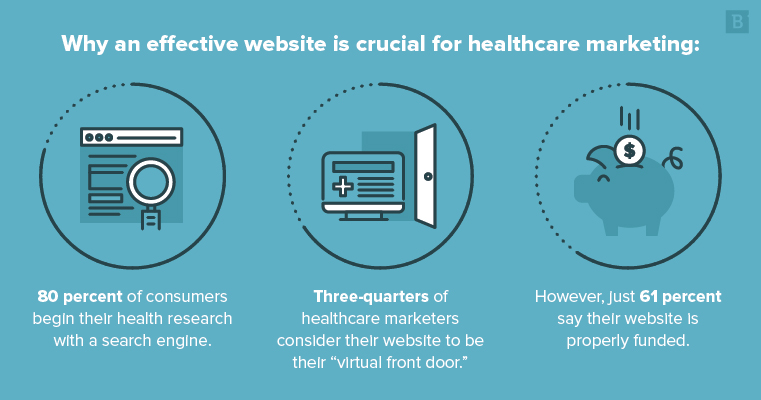Healthcare is incredibly personal and closely tied to quality of life.
Healthcare organizations’ marketing departments have many of the same goals as other companies, like bolstering brand awareness and sharing information about their services. But they also must strive to give consumers valuable information about their health and how to maintain it.

Let’s consider where people get health information today. If you’re like most people when they feel a little bit “off,” you’ll Google your symptoms. Nearly 80 percent of respondents to a 2013 Pew Research Center’s Internet & American Life Project survey said they begin their health research with a search engine. And 35 percent said they tried to self-diagnose their ailment based on online information (43 percent of those people said their doctors either fully or partially confirmed their conclusions).
With so many people turning to the internet to discover new information about their own or their loved ones’ health, it’s important that healthcare marketing is there to be a supportive and helpful guide.
With so many people turning to the internet to discover new information about their own or their loved ones’ health, it’s important that healthcare marketing is there to be a supportive and helpful guide. Despite this need, many healthcare provider marketing professionals say their organizations’ digital marketing lag behind other industries like e-commerce and finance.
Taking a few cues from these successful healthcare marketing strategies can help make providers more accessible to prospective patients:

1. Cleveland Clinic’s Health Essentials blog
Any content marketing professional will tell you, success starts with knowing what your readers want to learn. The Cleveland Clinic excels in this department with their Health Essentials blog.
The topics here are wide-ranging, covering subjects like healthy dinner recipes, the pros and cons of trendy supplements and information about specific ailments like adrenal fatigue.
What’s great about the Cleveland Clinic’s approach to content marketing is that it’s straightforward and often informed by experts about that specific topic. For example, that article about adrenal fatigue was largely written by the organization’s own endocrinologist Betul Hatipoglu. A high-performing infographic about smoothies for cancer patients was conceptualized by Lindsay Malone, a registered dietitian nutritionist and certified specialist in oncology nutrition at the clinic.
The Cleveland Clinic’s efforts are getting deserved attention. Some of their most popular posts have been shared thousands of times on Facebook and pinned to hundreds of Pinterest boards, according to an analysis I did using SharedCount.

2. Dr. Howard Luks’s videos
Video is a powerful tool that can go a long way toward educating viewers. YouTube is the second-largest search engine after its parent company, Google, and a HubSpot survey found that the No. 1 type of content consumers want to see from their favorite brands is video. Further, nearly one-quarter of consumers parsing through health information on social media stop to watch health-related videos, according to research conducted by PwC.
The wonderful thing about video is it’s so simple to make a short, informal one. But that’s also a challenge that might concern healthcare providers. Since anyone with a smartphone can upload their advice and opinions to YouTube, there’s an endless sea of incomplete information posted to the social media platform and others like it.
One study published in Health Promotion Perspectives analyzed 97 of the most widely viewed YouTube videos that discussed multivitamin and multimineral supplements. The videos averaged more than 200,000 views. The vast majority of them discussed benefits of the supplements, and 72 percent specifically recommended viewers use a particular supplement. However, many were lacking balanced information:
- 85 percent don’t mention risks associated with the supplements.
- 60 percent don’t discuss dosage or how to use the supplements.
- 55 percent don’t back up their claims with research.
Healthcare providers who want to provide complete and valuable information can work to fill these information gaps. Dr. Howard Luks is particularly adept at this. The New York-based orthopedic surgeon and sports medicine specialist began his YouTube channel in 2011 and now has nearly 2,000 subscribers to his channel.
Some of his most popular videos have well over 50,000 views, such as the 2013 upload, “Why Does My Shoulder Snap or Pop?,” which has more than 64,000 views. In 2 minutes and 43 seconds, Luks explains the anatomy of the shoulder, puts most viewers at ease (“For the vast majority of you, the reason why your shoulder is snapping or popping is simply because it’s you. It’s normal.”), then dives into several less-common issues that can lead to a snapping shoulder.
Luks’s videos are informal, many appearing to be filmed by the doctor himself. It’s usually just him with no props or guests, and he often explains at the beginning of the video that the topic is based on questions he gets from patients and online followers. These are great for social sharing or embedding into email marketing campaigns.
3. 2 Docs Talk podcast
Podcasts provide an excellent platform for people to share their ideas. Today, there are more than 550,000 podcasts available through Apple. More importantly, there are more than 120 million podcast listeners; 44 percent of Americans said they’ve listened to at least one.
Podcast fans are a fantastic audience. They’re incredibly loyal (17 percent are weekly listeners, and 80 percent listen to all or most of their chosen episode). They also love to discover new content. Listeners subscribe to six shows and listen to seven different shows per week on average.
Because of the popularity of podcasts, and ease of access, it only makes sense for organizations to include them in their marketing strategies. That’s exactly what Kendall Britt and Amy Rogers, both Texas doctors, did when they created 2 Docs Talk.
The women discuss healthcare-related matters in 15-minute episodes. The topics range from questions today’s consumers might find themselves asking (“Is Gluten Free the Answer?”) to policy discussions (“Healthcare in a Donald Trump Presidency”) to timely health concerns (“Lyme Disease – What It Is and What It Isn’t”). Their goal is to inform consumers so they can make smart decisions about their own healthcare.
Podcasts are a unique marketing tool in that the host’s personality shines through easily, which can help strengthen the bond between a brand and its listeners. Plus, it offers a dedicated space to interview experts in your industry or from your own organization. Like Cleveland Clinic’s method of sharing helpful advice through its blog from its own experts, having a dedicated host and revolving specialists to talk about various aspects of your organization can bring those voices to the forefront to connect with patients.
4. Zocdoc’s user-friendly website
Consumers today are used to accomplishing nearly any task online, and that includes scheduling a doctor appointment. It makes sense, then, that three-quarters of healthcare marketers consider their website to be their “virtual front door”.
However, just 61 percent of those marketers said their website is properly funded. What’s more, 86 percent of all survey respondents indicated that their practice’s website was one of their digital marketing strategies – an odd drop from the 95 percent who said the same in 2015.
Websites are critical touchpoints for practically every business in every vertical. But they’re especially important for healthcare systems, where consumers seek details about clinicians, health concerns and other important information. Plus, it’s becoming more common for people to schedule appointments, review prescriptions and communicate with their healthcare providers through patient portals. If the website is poor quality, lacking information or simply difficult to navigate, people can get frustrated seeking what they need.
This is why Zocdoc’s user-friendly platform is a welcome sight. The company is not a healthcare provider but rather a resource to help patients find the right one. On the home page, users fill in what they’re looking for, where they live and which health insurance they carry. The brand’s bright colors and simple messages make it relatable.

Practices can use this tool to boost visibility and show patients exactly which services they offer and when they’re available for appointments. Users’ abilities to rate and comment on their experiences gives prospective patients a view into what they can expect from their appointment. It also serves as a brand management tool for providers. Doctor information, star ratings and locations all appear in Google SERPs, which is good news for practices hoping to catch the attention of local patients.

The power of content marketing isn’t lost on Zocdoc. The website also has two very active blogs – one that’s patient-facing called The Paper Gown, and one that’s physician-facing called The Script. Dividing their content marketing into two separate resources is ideal for speaking to two unique audiences that are looking for very different information. Healthcare providers who cater to diverse populations can use this strategy, too.
Healthcare marketing isn’t always easy, but just like in any other industry, successful strategies come down to the basic pillars of what people want to know and how they will find it. Creating user-friendly, relatable resources like blogs, videos, podcasts and responsive websites can capture their attention. After that, it’s the quality of the content that matters.






